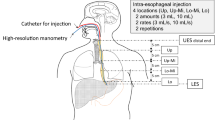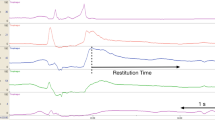Abstract
Extensive physiological studies of swallowing have been carried out in laboratory animals; however, similar studies in humans have been limited by available technology. In this study we describe the use of a solid-state circumferential sphincter transducer to define manometric characteristics of the human pharynx and upper esophageal sphincter (UES). Effects of pharmacologic agents and thermal stimulation are also described. We studied nine normal volunteers on three separate days. All studies were done in the upright position and consisted of a station pull-through of the UES and six wet swallows with the sphincter transducer in the most proximal segment of the UES and a posteriorly oriented single transducer 5 cm proximal in the pharynx. Baseline studies preceded all drug studies. Effects of bethanechol were studied on day 1, cold stimulation and benzonatate on day 2, edrophonium and atropine on day 3. The UES resting pressure showed large intrasubject day-to-day variations; however, mean values did not differ. There were no effects on UES relaxation or swallow coordination with any of the pharmacologic agents, although benzonatate produced multiple pharyngeal contractions.
Similar content being viewed by others
References
Miller AJ: Neurophysiological basis of swallowing. Dysphagia 1:91–100, 1986
Kahrilas P, Dodds WJ, Dent J, Logemann JA, Shaker R: Upper esophageal sphincter function during deglutition. Gastroenterology 95:52–62, 1988
Dodds WJ, Kahrilas PJ, Dent J, Hogan WF: Consideration about pharyngeal manometry. Dysphagia 1:209–214, 1987
van Overbee JJM, Wit HP, Paping RHC, Segenhout HM: Simultaneous manometry and electromyography in the pharyngo-esophageal segment. Laryngoscope 95:582–584, 1985
Isberg A, Nilsson ME, Schiratzki H: Movement of the upper esophageal sphincter and a manometric device during deglutition. A cineradiographic study. Acta Radiol Diagn 26:381–388, 1985
Kahrilas PJ: A method for continuous monitoring of upper esophageal sphincter pressure. Dig Dis Sci 32:121–128, 1987
Castell JA, Dalton CB, Castell DO: Pharyngeal and upper esophageal sphincter manometry in humans. Am J Physiol 258:G173-G178, 1990
Logemann JA: Evaluation and Treatment of Swallowing Disorders. College-Hill Press, San Diego, California, 1983
de Lama Lazzara G, Logemann JA: Impact of thermal stimulation on the triggering of the swallowing reflex. Dysphagia 1:73–77 1986
Mansson I, Sandberg N: Effects of surface anesthesia on deglutition in man. Laryngoscope 84:427–436, 1974
Author information
Authors and Affiliations
Rights and permissions
About this article
Cite this article
Knauer, C.M., Castell, J.A., Dalton, C.B. et al. Pharyngeal/upper esophageal sphincter pressure dynamics in humans. Digest Dis Sci 35, 774–780 (1990). https://doi.org/10.1007/BF01540183
Received:
Revised:
Accepted:
Issue Date:
DOI: https://doi.org/10.1007/BF01540183




